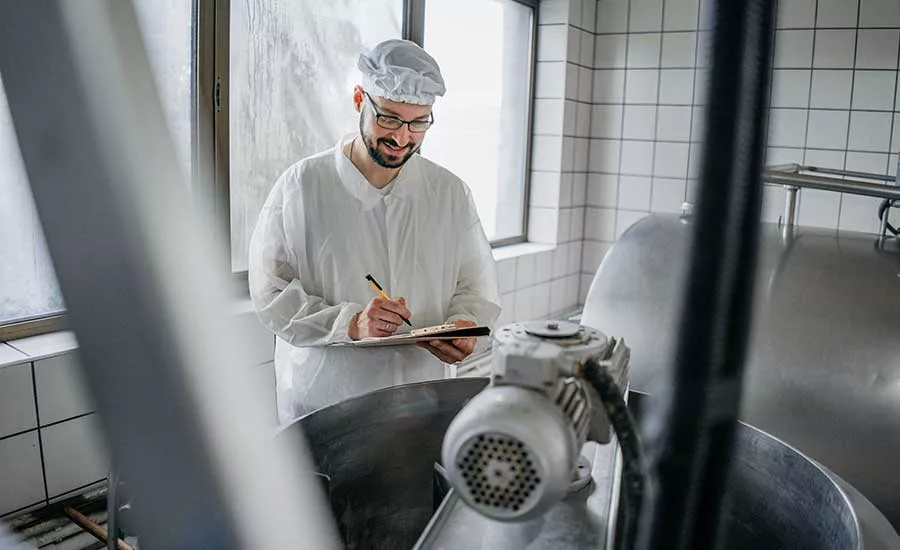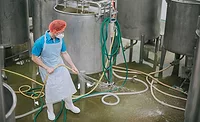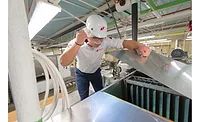Simplifying Sanitation Standard Operating Procedures
Cleaning/sanitizing SOPs should not be integrated to the "regulatory" requirements of SSOPs, but instead maintained as a separate set of documents

Image credit: Nikola Stojadinovic/E+ via Getty Images
It is my hope that those who worked with me during my food industry career found me to be a logical, thoughtful, and rational individual when it comes to developing and implementing food safety and quality programs. However, there are certain things that I hear during discussions with food professionals that drive me crazy—and it is sometimes a very short drive! For example, I can feel myself starting to cringe when I hear someone refer to "my SSOPs" plural! Although I try not to sound incredulous, my retort is often, "Why would you have multiple SSOPs?" As the discussion progresses, it becomes clear that what they are referring to is a conglomeration of their SSOP and their general cleaning procedures, which then leads to another serious discussion as to why these documents have been combined.
In this article, I present my thoughts on how general cleaning procedures (Standard Operating Procedures, or SOPs) differ from Sanitation Standard Operating Procedures (SSOPs) and why they should remain separate. First, I will define SOPs.
The Basics of Standard Operating Procedures
I like to use a quote from W. Edwards Deming when teaching about SOPs to help define their objective. Dr. Deming stated, "If you can't describe what you are doing as a process, you don't know what you're doing." The purpose of the SOP is to ensure that you understand the process and can define standardized steps in the process. By doing this, you can ensure an effective process to prevent food safety, quality, or productivity issues and to provide consistent output from the process. It is for this reason that the development of SOPs should be carried out with a cross-functional team of subject matter experts (SMEs) such as food safety and quality, operations, sanitation, etc. Their combined knowledge and perspective can help ensure that the details of the process, and even the terminology that is used, result in a document that shows the team understands the process and can implement continuous improvement or make corrections when challenges arise.
Developing a cleaning/sanitizing SOP will be driven primarily by sanitation leadership, but it should include input from food safety and quality, maintenance, and operations. An effective SOP will include what is to be done [covering sanitation personal protective equipment (PPE), tools, and steps for cleaning and sanitizing], how it is to be done (including process details, frequency of the steps, and limits to demonstrate conformance), as well as why it is being done (such as to eliminate potential microbial contamination, remove allergen protein, or to enhance operational efficiency).
The completed document will be used to train sanitation personnel, including new sanitors, and performance will be monitored to ensure conformance, as well as efficacy of the procedure. Observation of cleaning/sanitizing SOP implementation may result in changes to the procedure to improve efficiency and efficacy. In working with chemical supplier technical personnel, sanitation leadership may determine that a new or different chemical is needed for efficiency or efficacy. Supply chain disruption may change the types of PPE, utensils, or chemicals that will be used to guarantee that the sanitation process can be continued without disruption.
For these reasons, the general cleaning/sanitizing SOPs should not be integrated to the "regulatory" requirements of SSOPs, but instead should be maintained as a separate plant operational set of documents. To further explain the rationale for keeping these separate, it will be beneficial to review SSOPs to define their requirements and how they differ from general SOPs.
Sanitation Standard Operating Procedures
Following some of the foodborne illness outbreaks of the late 1980s and early 1990s, particularly involving meat and poultry products, the U.S. Department of Agriculture (USDA) took significant steps to implement new regulations to protect consumers and the food supply. These regulations included requirements for implementation of Hazard Analysis and Critical Control Points (HACCP) and Sanitation Standard Operating Procedures (SSOPs) with a focus on prevention rather than detection of food hazards. The regulations for SSOPs can be found in 9 CFR 416: Sanitation.1 The regulations state that USDA establishments will develop and implement procedures to prevent direct contamination or adulteration of meat and poultry products. Specifically, they address cleaning, inspection, and sanitizing of USDA facilities, as well as maintenance of sanitary conditions during operations. SSOP regulations are supplemented by FSIS Directive 5000.1: Sanitary Performance Standards, which address maintenance of the facility and grounds conditions that may impact sanitary operations. The SSOP document and the maintenance of operational conditions will be monitored by FSIS inspection personnel on a routine basis, specifically depending on the daily tasks they are assigned.
Looking for quick answers on food safety topics?
Try Ask FSM, our new smart AI search tool.
Ask FSM →
The SSOP document is usually reviewed by FSIS inspection personnel when they rotate into a facility. It is also reviewed by an enforcement investigation and analysis officer (EIAO) when they conduct a food safety assessment. They will specifically seek to determine if the regulatory elements of the SSOP are addressed. The specific requirements for the SSOP include the following:
- The business name and address of the establishment, establishment number, and contact information
- The names of the establishment management personnel who are involved in decision-making and the sanitation process (this may include the owner/CEO, quality assurance manager, and sanitation manager)
- Specific verbiage regarding responsibility for implementation and upkeep of the SSOPs, monitoring, recordkeeping, and documentation of corrective actions, including the maintenance of checklists and their availability to inspection personnel
- Specific verbiage instructing that all food contact equipment and facility surfaces, including utensils, will be cleaned and sanitized prior to the start of production on a specified frequency
- General cleaning procedures that include verbiage such as:
- Equipment will be disassembled as needed prior to cleaning
- Product debris will be removed
- Equipment and parts will be rinsed with clear, potable water to remove remaining debris
- Chemical cleaner will be applied to parts and equipment to remove soils
- Equipment and parts will be rinsed with clear, potable water to remove cleaning chemicals
- Parts and equipment will be inspected, and all findings will be documented including corrective actions for non-conforming findings
- Sanitizer will be applied, and equipment will be reassembled
- Operational sanitation will be monitored to ensure that all operations are properly conducted
- Documented operational inspection will be conducted, including corrective actions for any non-conforming findings.
The SSOP document will be signed and dated by the person at the establishment with the highest authority for decision-making. The SSOP will also be reassessed for needed changes at least annually, or if significant food safety issues (microbiological, chemical, or physical) occur or a product removal action (such as a recall) is initiated. Any modifications will be signed by the person with the highest authority at the establishment.
Simplicity is Key (and Highly Beneficial)
The SSOP document is straightforward and fairly simple. It can be as short as two pages and should not be longer than three. It meets regulatory requirements, but does not delve into specific details such as water temperatures, chemical strengths, mechanical actions, or specific chemicals and tools used for sanitizing.
Why is simplicity important in an SSOP? As previously mentioned, the SSOP is a document that USDA inspection personnel can request to review. If it is written to meet specific regulatory requirements, then it will comply with regulation and should not result a noncompliance report or noncompliance findings during a food safety assessment. Remember, the more detail that is included in an SSOP, the more elements USDA will be able to assess for compliance. Unnecessary details provided in the SSOP that may not be specifically or consistently met (i.e., water temperatures, chemical strengths, tools used) can result in noncompliance reports.
Your company may occasionally trial different chemicals, or you may experience supply challenges that restrict the availability of PPE, or new personnel may not prove to be proficient at their job. All of these can result in a noncompliance finding by inspection personnel. For this reason, I recommend keeping SSOP information and general cleaning/sanitizing documentation separate, as this allows you the flexibility to clean the plant effectively even if it is not consistent with your general procedures.
References
- Code of Federal Regulations. Title 9, Chapter 3, Subchapter E: "Part 416—Sanitation." July 25, 1996. https://www.ecfr.gov/current/title-9/chapter-III/subchapter-E/part-416.
Michael Cramer, CQA, PCQI, retired in July 2021 as Senior Director of Food Safety and Quality Assurance for Ajinomoto Foods North America. He is a graduate of West Chester University with a B.Sc. degree in health science. He has spent over 40 years in food manufacturing for meats, poultry, and frozen entrées. He authored the book Food Plant Sanitation, as well as numerous articles for Food Safety Magazine, where he is a member of the Editorial Advisory Board. He is a Certified Quality Auditor and PCQI.






